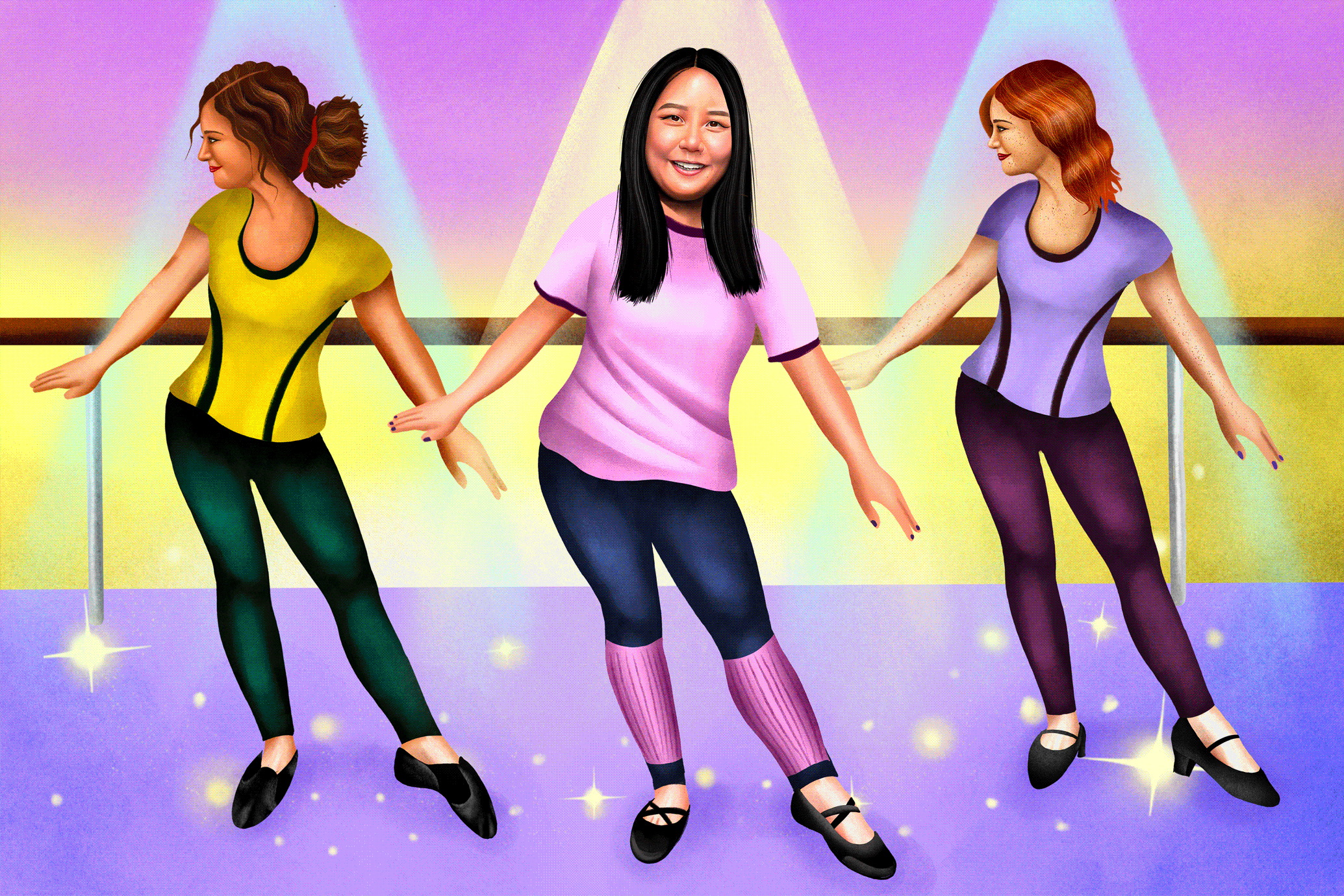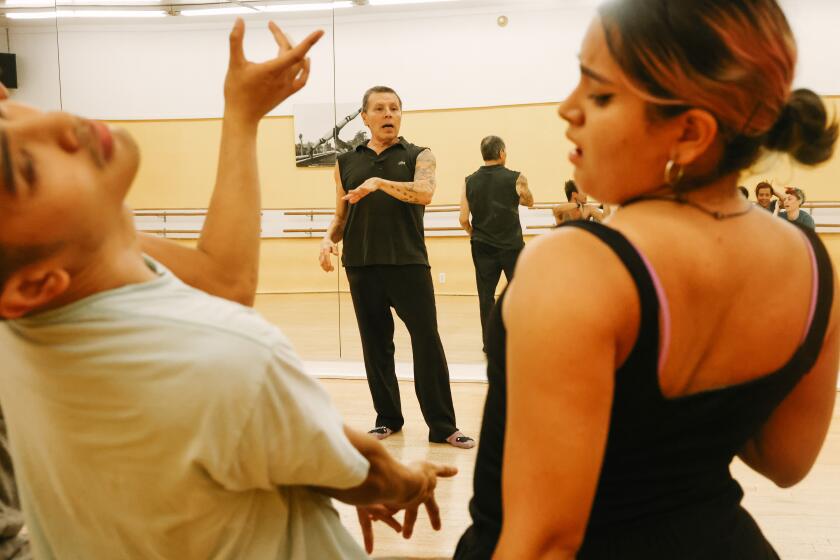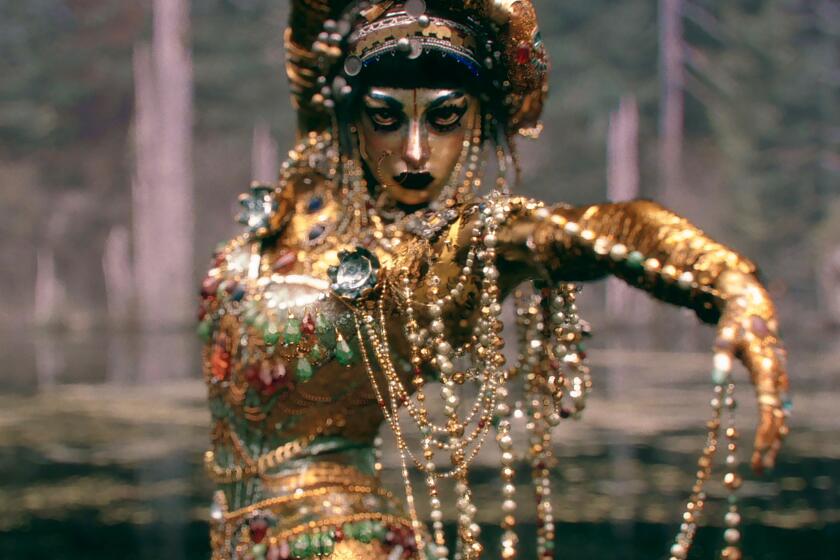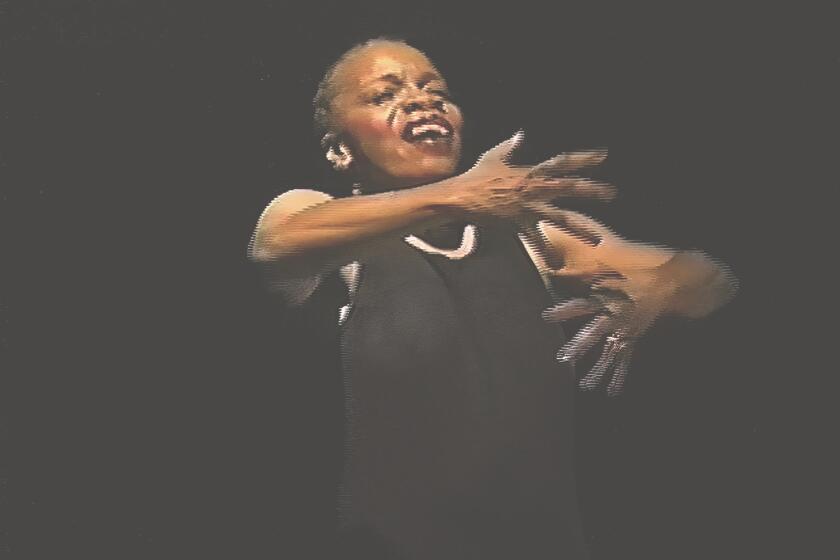- Share via
Choreographer Chuck Maldonado gives a glimpse of what it’s like to choreograph for film and T.V.
- Share via
When fans of the American version of “The Office” hear the piercing synth at the beginning of the Chris Brown song “Forever” — followed by the staccato chant “One, two, three, four!” — they’re likely to think of love. Not only the type of love that moves “at the speed of light into eternity,” but the slow-burn love between co-workers Jim (John Krasinski) and Pam (Jenna Fischer) that took six seasons to build.
The song plays as the couple’s Dunder Mifflin colleagues misguidedly — but sweetly — disrupt the couple’s wedding procession, and it gives cast members a chance to show off their amateur dance moves.
“I think any time you add dance ... it makes people want to watch,” said choreographer Chuck Maldonado, whose credits include “Stomp the Yard,” “Step Up Revolution” and the video explainer above, where he teaches L.A. Times producer Mark Potts a newspaper-themed musical number.
“It makes people like the show,” he said. “It makes people like the song more, and the person. Because now they’re like, ‘Wow, he can not only act and sing, but he’s also a great dancer.’”
In Hollywood, choreographers aren’t needed just for show-stopping musical dance numbers. They’re hired whenever any type of coordinated movement is going to be filmed.
If there’s a club scene, choreographers are hired to hype up the crowd and suggest moves, Maldonado said, because it can be harder than it seems to not look awkward on a dance floor. Choreographers also often help with long takes called “oners,” where everything happening onscreen needs to be tightly executed.
It’s dancers and choreographers who instinctively understand timing. Maldonado recalls doing a gig for Steven Spielberg’s “Indiana Jones and the Kingdom of the Crystal Skull” where dancers were hired to perform a stunt because dozens of people needed to slide down a pyramid and get to the bottom at the same time. “We timed it by eight counts,” he said.
But often, film and TV choreographers are working with non-dancers. For example, the film “La La Land” featured many eye-catching dance performances, but stars Emma Stone and Ryan Gosling aren’t professional dancers.
“Usually in those situations, my job is not to train them to be professional dancers,” said the film’s choreographer, Mandy Moore (not to be confused with the singer and “This Is Us” actor). “It’s to coach them to a point where they can do what they need to do for their characters in the story.”
A good illustration comes from Mimi Karsh, an assistant choreographer on the wedding dance sequence in “The Office.” Her first big break as a choreographer was on “Don’t Trust the B— in Apartment 23.” James Van Der Beek played himself, and he requested a choreographer for an episode where he was a contestant on “Dancing with the Stars.” (This was seven years before he was a “Dancing With the Stars” contestant in real life.) He felt like he needed training for the story to be believable, said Karsh.
The joke in the episode is that his character learns how to do the routine well, but on the day of the performance, he is accidentally drugged and makes a fool of himself on live TV. So there are two versions of the dance in the episode: the good one and the intoxicated one.
Karsh taught Van Der Beek the moves, she explained, but it was the hours of rehearsal that allowed him to become so comfortable with the choreography that he could concentrate on the acting and physical comedy when it was time to mess the routine up.
That’s the ultimate goal of the choreographer: to make it look easy.
To learn more about being a choreographer for film and TV, The Times spoke with Karsh, Maldonado, Moore and fellow professionals Emilio Dosal, Sonya Tayeh, Alison Faulk, Luke Broadlick, Choreographers Guild President Kathryn Burns, interim executive director of the Choreographers Guild Steve Sidawi, and agent Julie McDonald of McDonald Selznick Associates. Here are some of their insights.
Choreographers whose works were performed in Los Angeles this year share how the pandemic, as well as loss, stillness and joy, reshaped their perspective and practice.
Who becomes a film and TV choreographer?
Usually, it’s the professional dancers who have been dancing since they were kids.
But there are exceptions. For example, Dosal — associate choreographer on “In The Heights” who won an Emmy choreographing Disney’s “Sneakerella” — and Broadlick — known for his work on the “Magic Mike” trilogy — started in martial arts. Dosal competed nationally in taekwondo with dreams of qualifying for the Olympics before he transitioned to dance. Broadlick was also a martial arts champion who later pivoted into acting and got his start as a dancer on Britney Spears’ Circus tour. He later got his first choreographer credit for the Femme Fatale Tour’s martial arts rendition of “Toxic.”
Tayeh, who choreographed Broadway’s “Moulin Rouge,” still doesn’t consider herself a dancer. She thinks the assumption that you need to be a professional dancer in order to be a choreographer is “very limiting and can be discouraging for a dancer who has stage fright.”
Tayeh was never quite comfortable performing, but she was obsessed with understanding how to make the dances. “It’s a very different training, philosophy and brain focus,” she said. “I just loved watching the dance and being curious about how you can provoke a feeling in someone.”
There are a lot of different types of choreographers in the entertainment industry. Choreographers can work in theater, commercials, music videos, concert tours, live events, film, television and more.
Within the mediums of film and TV, there are further breakdowns. There are reality television shows like “Dancing With the Stars.” There are scripted projects where dance is an integral part of the storytelling; for example, “Zoey’s Extraordinary Playlist,” co-produced by Moore, where the lead character can see people’s innermost thoughts through song and dance. And there are lots of gigs where choreographers are hired short-term to help with specific scenes.
Inside the rehearsal for Jamar Roberts’ project ‘Lineage,’ which the former dancer turned choreographer created with L.A. Dance Project.
The choreographers who thrive in those jobs often have a different personality types, Karsh said. While Broadway and tour choreographers are usually large and in charge, the hierarchy is different in the scripted-film and TV world, she said. Film and TV choreographers — like everyone else on set — are there to serve the director or showrunner’s vision for the story.
It’s not uncommon for a choreographer to be on set and have 15 minutes to coach the actor between takes, the professionals say, because actors tend to have very tight schedules. Rehearsals can feel like a luxury, Karsh said.
So in these circumstances, the most important thing is to be a person who doesn’t stress out the actors, who are often already nervous about the dance portion, she said.
“A good choreographer always comes prepared,” said Maldonado. “Not only with material they’re going to [try to teach] the actor, but also B and C material in case they don’t pick up A.”
It’s also normal for things to change at the last minute, said Faulk. “Not because people aren’t good at their jobs; there are just so many people involved,” she said. “You have to be really OK with, ‘OK, we just prepped all that, but now it has to change because we got new script pages or they don’t want to use that song anymore.”
At the same time, it’s a challenging and competitive industry. “You need a sense of relentlessness and drive,” said Tayeh. While she considers herself a shy and nervous person, she knows she always needs to be prepared to walk into a room with confidence and advocate for her vision.
Aspiring choreographers should also know that there’s not a lot of stability in this career path, said Faulk. “You have to say yes to everything all the time, and when you get a job, it becomes your life for that amount of time,” she said.
“This is one of those jobs where it’s not a job,” she added. “It’s your passion, your heart, your love — something you have to do.”
How do you get started?
The experts agree that it’s important to learn as many genres of dance as possible. This will help you get more dance jobs — for the majority of aspiring choreographers who will start as dancers — and make you more versatile as a choreographer.
“People who hire you often don’t really know what they want until they see it,” said Dosal. “It’s best to always have an arsenal of things, so that you can continue to turn their heads.”
Take a lot of classes, experts said. While there are many well-known dance studios in Hollywood, Karsh recommends following choreographers you admire. Most teach at multiple studios, she said.
Classes are also where you can start to find your community — and offer your help if anyone ever needs an assistant, she said.
The nascent Choreographers Guild is another resource for education and networking. Karsh also recommends submitting your work to the Choreographer’s Carnival, an open showcase for choreographers’ routines.
Once you start getting opportunities, take any job that can help you learn how the set works, the experts recommend. “Everything moves so quickly, and no one really teaches you any of this, so you have to kind of learn by watching,” said Burns, who choreographed more than 60 episodes of “Crazy Ex-Girlfriend.”
Many make the mistake of focusing only on their own jobs when they’re on set, said McDonald, who’s credited with starting the first agency specializing in dancers and choreographers in the ‘80s. It’s important to understand the different departments and hierarchies, she said, adding, “Use every opportunity as a learning experience and to get to know people.”
And don’t look down on the gigs that don’t require complicated moves. “I made a lot of money in my early career doing commercials that you would never think even had choreography,” said Moore. “I was hired to help a model sit down in a chair on count five, and that was my job for the day.”
“I’ve trained my whole life to do kicks and turns and jumps and leaps,” she continued, “but also my knowledge of how to explain somebody how to sit correctly on the right count is also part of the skill set you need as a choreographer.”
To become efficient and effective at the job — which is what gets you hired back, McDonald said — you need teaching experience.
It could be working at a professional dance studio or teaching kids and seniors — which Moore did for years. “You don’t have to be teaching them the best moves,” she said. “It’s just about gaining experience working, coaching and guiding people.”
When you are able to gather enough material for an impressive reel, look for an agent or manager.
“The most important thing is to find someone who you like to work with and will advocate for you,” Karsh said.
“If you are a dancer and are represented at an agency with a choreography department, let them know that you are interested in moving towards choreography work, and they can help guide you towards that goal,” she said. “If you don’t currently have representation, you can look into submitting to choreography departments. Some places will accept submissions of your reel, and other places are referral-based.”
Though McDonald has signed inexperienced clients purely on the merit of their submission, it’s rare. Agents prefer to go with clients who have a proven track record, she said.
“It starts with you,” said Tayeh. “In this career, you’re hustling and pushing and describing your desires all the time. Survival, for me, is to make sure I have a really clear vision and belief system.”
It helps to create a unique style, Burns said. “That’s something that takes time to build,” she said. “I also did comedy at Upright Citizens Brigade, so for me, it was like the worlds of comedy and dance coming together.”
All of this work is to make sure you’re prepared when you’re eventually at the right place at the right time, experts say.
Faulk was choreographing the Britney Spears tour that Broadlick was dancing on when she needed a male dancer to help with the first “Magic Mike” film. One day, Broadlick was goofing around, giving his fellow performers lap dances, and he ended up on top of Faulk.
She gave him his first assistant choreographer job. “We needed a guy who could flip, and you kind of have to like that sexy kind of dancing to want to do it,” she said.
Los Angeles’ nightlife thrives on its dance halls, lounges, bars and community hubs. Kick off your weekend at one of the 57 hottest clubs in the L.A. area.
What are the career paths?
There is no one path, experts agree. But McDonald said this is a common route: You’re hired as a dancer. You get the attention of a choreographer, who eventually asks you to assist. You assist them for a long time to learn the ropes until someone gives you a shot at being the associate choreographer. Then you work your way up to choreographer.
Dosal, associate choreographer on the upcoming “Wicked” film, explains the roles further. As a dancer, “your whole job description is to go to rehearsal, you get told what to do, you do it, and then you go home, you get to sleep and do it all over again,” he said.
An assistant choreographer’s job is to be there with the choreographer at all times to help them make their ideas come alive, he said. “So if the choreographer is saying, ‘I need to move this choreography from point A to point B,’ the assistant’s job is to go, ‘OK, I think they can do this, this and this.’”
As an associate choreographer, you have an opportunity to be a part of the creative process, Dosal said. You can suggest different concepts and collaborate with the choreographer, who ultimately decides what to use.
The choreographer’s role, in comparison to the other jobs, is massive, he said — because it’s a managerial position. The job is no longer only about the dance moves.
You’re in meetings with the director to understand what they need the dance to accomplish, Dosal said. You’re talking to the costume designer because you need gussets in the pants so they don’t rip when the dancers do flips. You’re talking to the producer if you need to advocate for extra days of shooting. You’re talking to the casting director to help assess which dancers will be able to handle the film’s choreography. You’re meeting with the music department.
You have to be very organized and answer a lot of emails in a timely manner, he said.
While there are definitely those who want to remain assistants or associates, McDonald’s job as an agent is to develop careers and take a dancer from assistant to associate to choreographer — and for some, director.
Transitions are difficult, she said. “Just because you have a lot of assistant jobs on your resume doesn’t necessarily get you a choreographer job,” she said. “You have to come up with with your own tools, videos and examples to show what you could bring.”
Also, when you want to move to the next level, you often have to turn down a lot of work at your current level, she said. “Sometimes you need to make sacrifices,” she said.
To progress in this career path, professionals agree it’s important to understand that Hollywood is a small world and people talk. You want to be someone whom people recommend, not someone whom veteran choreographers warn each other about.
Inside the rehearsal for Jamar Roberts’ project ‘Lineage,’ which the former dancer turned choreographer created with L.A. Dance Project.
How do you make money? (And what kind of money?)
When you’re starting out as a young choreographer, the rates are likely to be very low, Moore said. “But I try to tell people it’s important to take those lower-level jobs, because that’s where you really cultivate the relationships with people who will help hire you later,” she said.
There’s no standard day rate for choreographers, so the pay varies widely. “Some people might get $500 a day, which is on the low end, and then someone might get paid $5,000 or more if there’s a large budget and you’re in demand,” said Faulk.
Choreographers are among the few professionals in Hollywood who are not yet unionized, said Sidawi. That’s why pros are forming the Choreographers Guild to advocate for choreographers in film, TV, concert tours, award shows and music videos.
In the meantime, there is a the Stage Directors and Choreographers Society, which represents Broadway and other theater shows. There is the American Guild of Musical Artists, which supports opera, choral performance and concert dance. And choreographers who also work on camera as dancers can join SAG-AFTRA, which is one way to gain health and pension benefits.
Once it’s up and running, the Choreographers Guild will help its members negotiate not only for wages but also for residuals, royalties and credit. Burns said she was once left out of the credits of an Oscar-nominated film she worked on.
“Choreographers typically are hired by themselves, so it’s a lot to navigate on your own,” she said. “And you’re often fighting for two days of work, so it doesn’t seem worth jeopardizing the relationship to try to negotiate things that are pretty standard for everybody else.”
Part of the guild’s goal is to educate people to value choreography like they value writers, said Burns. Choreographers create a story nonverbally, she said. It’s also a specialized skill that requires a lot of knowledge.
“When they say they want Fosse, do they mean they want dark moody lighting?” said Burns. “Do they want it to be sexy and burlesque? Do they want it to be campy? When someone says hip-hop, do they want ‘90s, funk, popping, locking?”
When in doubt about how to navigate pay, speak to an agent, Burns recommended. And although it sounds simple, she said, it’s worth reiterating in a profession widely seen as chronically undervalued: A choreographer should at the very least be paid more than a dancer.
As the last member of a dance movement that emerged in L.A.’s queer club scene in the 1970s, Viktor Manoel is teaching a new generation of dancers who are uplifting the style and its history.
How is this career different than it was 10 or 25 years ago?
When Moore first moved to Los Angeles in the early ‘90s, she said, it seemed like people had tired of the dance music videos of the ‘80s and dance had disappeared. But it started coming back with the return of the boy bands.
It was around the mid-2000s when Tayeh started seeing a movement toward showcasing dance not only for music artists, but in commercials (for iPods, Gap and Old Navy), runway fashion, dance films and reality competitions.
Dosal started coming up during the rise of YouTube in the late 2000s. “If you had a camera and a tripod, you’d set that up in front of a mirror, record a dance class and throw it up on YouTube,” he said. “And regardless of whether it went viral or not, it was a way of showcasing the work and embracing each other as part of a movement.”
Faulk thinks it’s great that the newer generation of choreographers can film themselves and quickly understand how to look at dance through the lens of a camera phone.
And now, it’s all about TikTok, Instagram and other social media — which can send even a newcomer’s career skyrocketing.
“I’m going to be honest with you,” said Maldonado. “I was one of those bitter, bitter party-of-ones at first, because I was used to the way we had always done it.” Nailing a TikTok routine doesn’t necessarily develop the stamina it takes to rehearse for consecutive eight-hour days, he said, and veteran professionals know that.
But, he said, there has been rush of professional dancers and choreographers posting on social media — especially during the pandemic, when they were out of work — and now he thinks it’s a great way to showcase your talents.
“Nowadays, people use it as a personal website,” said Karsh. “Be proactive about showing your unique style and what you can do. Post it!”
The choreographer’s Emmy-nominated “Jibaro” episode of “Love, Death & Robots” distinctly explores fluidity and destruction.
What advice do pros always hear that is wrong?
“I think sometimes people look at dance like it’s so common,” said Moore. “Because everybody can kind of dance, I guess. ... But I describe it like, ‘Imagine sprinting as hard as you can in place for, like, one minute. And then you’re also wearing high heels and a skirt.’ That’s what dancing is like, and you’re acting and doing everything else on top of it.”
“It’s our job to make it look easy,” she added, “but if you only knew.”
There are enough challenges behind the scenes that Maldonado said he stopped judging a person’s individual talent based on the final collaborative product.
“I hate it when I hear people say, ‘Oh my God, the choreography was horrible’ or ‘The artists suck at dancing,’” he said. “You don’t know how hard those people had to work just to get it to look like that.”
The subject of a new book and recent solo exhibition, the late Blondell Cummings drew from theater and performance art to create her distinctive choreography.
What’s some good advice?
Familiarize yourself with camera work and editing. “Dancers and choreographers are full-on filmmakers,” said McDonald. “They’re always filming with their friends.”
Sometimes directors will ask choreographers for advice on how to shoot the dance. Other times, you might adjust the choreography depending on how they plan to shoot.
“It’s about: How do you get those ‘Wow moments?’” said Maldonado.
Maximize your own potential. Dosal said when he started auditioning, he noticed he was usually the shortest person in the room. So he’d push his arms out further during the dances. He’d put more vigor into his flips. “What ended up happening is, I’m in the air, and casting directors end up turning in my direction,” he said. “And they’re like, ‘Oh, this kid’s flying. This tiny kid is bigger than the rest of them right now.’”
Look into being a movement coach. Austin Butler used a movement coach to learn how to embody the physicality of Elvis, Burns pointed out. Ke Huy Quan hired one to help him keep track of all the Waymond characters in the “Everything Everywhere All at Once” multiverse.
Choreographers can often use their skills to help actors practice getting into the physicality of a character or help directors map out an intimate scene, she said.
Be patient. “It just takes a long time,” Moore said. “I think it’s really hard for people because they feel like if they don’t get it in the first couple years, it’s over. I didn’t quite have a [Hollywood] career until the last 10 years, and I’ve been here since 1994.”
Moore thinks fondly of the decidedly unglamorous scene in the parking lot of the “La La Land” production office, when she and her assistants were experimenting with different ways dancers could get out of their cars. She went from lying under a vehicle on a freeway to help dancers on top of cars hit their marks to watching the epic opening number come to life on the big screen at the Venice Film Festival premiere.
“It’s a really fun career path, man,” she said. “It’s not easy, but it’s so fun.”
About The Times Utility Journalism Team
This article is from The Times’ Utility Journalism Team. Our mission is to be essential to the lives of Southern Californians by publishing information that solves problems, answers questions and helps with decision making. We serve audiences in and around Los Angeles — including current Times subscribers and diverse communities that haven’t historically had their needs met by our coverage.
How can we be useful to you and your community? Email utility (at) latimes.com or one of our journalists: Jon Healey, Ada Tseng, Jessica Roy and Karen Garcia.
Careers in the entertainment industry can be mysterious for those just starting out, and even for those working in the business. The Los Angeles Times brings you explainers and advice for starting and building your career in Hollywood.
More to Read
Inside the business of entertainment
The Wide Shot brings you news, analysis and insights on everything from streaming wars to production — and what it all means for the future.
You may occasionally receive promotional content from the Los Angeles Times.



















